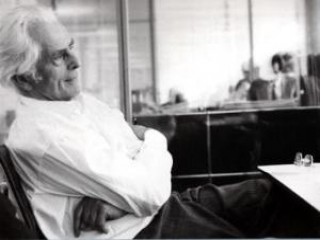
Frei Otto biography
Date of birth : 1925-05-31
Date of death : -
Birthplace : Siegmar,Germany
Nationality : German
Category : Arhitecture and Engineering
Last modified : 2012-01-17
Credited as : architect, structural engineer, founded the famous Institute for Lightweight Structures
0 votes so far
Otto was born in Siegmar (since 1950 a part of Chemnitz). He studied architecture in Berlin before being drafted into the Luftwaffe as a fighter pilot in the last years of World War II. It is said that he was interned in a French POW camp and, with his aviation engineering training and lack of material and an urgent need for housing, began experimenting with tents for shelter. After the war he studied briefly in the United States and visited Erich Mendelsohn, Mies van der Rohe, Richard Neutra, and Frank Lloyd Wright. He began a private practice in Germany in 1952. His saddle-shaped cable-net music pavilion at the Bundesgartenschau (Federal Garden Exposition) in Kassel brought him his first significant attention. He earned a doctorate about tensioned constructions in 1954.
Otto is the world's leading authority on lightweight tensile and membrane structures,[citation needed] and has pioneered advances in structural mathematics and civil engineering. Otto's career bears a similarity to Buckminster Fuller's architectural experiments: both taught at Washington University in St. Louis in the late 1950s, both were architects of major pavilions at the Montreal Expo of 1967, both were concerned with space frames and structural efficiency, and both experimented with inflatable buildings. The work of both men go far beyond traditional methods of calculating structural stresses. His designs are regarded to have been heavily influenced by Australian architect Barry Patten, and his most famous design, the Myer Music Bowl (1959) in Melbourne.
Otto founded the famous Institute for Lightweight Structures at the University of Stuttgart in 1964 and headed the institute until his retirement as university professor. Major works include the West German Pavilion at the Montreal Expo in 1967 and the roof of the 1972 Munich Olympic Arena, inspired by Vladimir Shukhov's architecture.
The International Architecture Symposium "Mensch und Raum" (Man and Space) at the Vienna University of Technology (Technische Universität Wien) in 1984 received in international attention. Otto participated, among others: Justus Dahinden, Dennis Sharp, Bruno Zevi, Jorge Glusberg, Otto Kapfinger, Paolo Soleri, Pierre Vago, Ernst Gisel, Ionel Schein.
Otto is still active as an architect and engineer. One of his more recent projects was his work with Shigeru Ban on the Japanese Pavilion at Expo 2000 with a roof structure made entirely of paper.


















